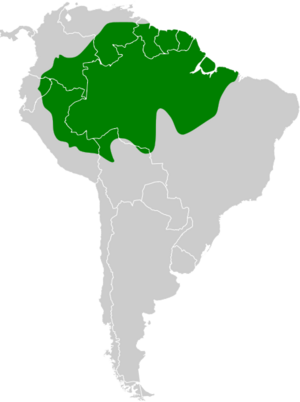Cinnamon-rumped foliage-gleaner facts for kids
Quick facts for kids Cinnamon-rumped foliage-gleaner |
|
|---|---|
 |
|
| Conservation status | |
| Scientific classification | |
| Genus: |
Philydor
|
| Species: |
pyrrhodes
|
 |
|
The cinnamon-rumped foliage-gleaner (Philydor pyrrhodes) is a cool bird that belongs to the ovenbird family called Furnariidae. It lives in many countries in South America. You can find it in places like Colombia, Venezuela, Ecuador, Peru, Bolivia, and Brazil. It loves living in tropical forests.
Contents
About This Bird
This bird is quite special because it's the only one of its kind in its group. It doesn't have any subspecies, meaning all cinnamon-rumped foliage-gleaners are very similar!
What It Looks Like
The cinnamon-rumped foliage-gleaner is about 14 to 17 cm (5.5 to 6.7 in) long. It weighs around 24 to 35 g (0.85 to 1.2 oz), which is about as much as a few quarters. Both male and female birds look the same. They have bright colors on their undersides.
They have a yellowish ring around their eyes. There's also a faint brownish stripe behind their eyes. Their crown, which is the top of their head, is a dark reddish-brown. Their back is also reddish-brown, but their rump is a brighter reddish-orange. Their tail is a very bright orange-red.
Their wings are dark brown. Their chin, throat, chest, belly, and the feathers under their tail are a bright orange-yellow color. Their eyes are brown. Their beak is dark gray on top and silvery gray underneath. Their legs and feet are olive-green. Young birds look similar but have browner upper parts and a lighter throat.
Where It Lives
The cinnamon-rumped foliage-gleaner lives in many parts of South America. You can find it from southeastern Colombia all the way to southern Venezuela and the Guianas. It also lives south through eastern Ecuador and Peru into northern Bolivia. From there, it spreads east through Brazil.
This bird loves tropical lowland forests. It can be found in forests that are always green, even when flooded. It also likes terra firme forests, which are on higher, drier ground. It especially likes areas with lots of palm trees. These birds usually live below 400 m (1,300 ft) in elevation. However, they can sometimes be found higher, up to 600 m (2,000 ft) in Colombia and 500 m (1,600 ft) in Brazil.
How It Behaves
Staying in One Place
These birds don't migrate. They stay in the same area all year long.
What It Eats
We don't know everything about what the cinnamon-rumped foliage-gleaner eats. But we do know it eats arthropods, which are creatures like insects and spiders. It usually looks for food alone or with a partner. Sometimes, it joins groups of different bird species that are feeding together.
It mostly searches for food in the lower parts of the forest. However, it can also go higher up into the trees. It's very good at moving around to find its prey. It pulls insects from live and dead leaves, bits of plants, and palm fronds. It often feeds in places where the plants are very thick and dense.
Making a Family
Scientists don't know much about how the cinnamon-rumped foliage-gleaner breeds. We don't have details about their nests or how they raise their young.
Its Calls and Songs
The song of the cinnamon-rumped foliage-gleaner is quite interesting. It starts as a long, low trill that slowly gets louder. Then, it changes into a louder, vibrating trill that goes up in pitch and stops suddenly. Its contact call, which is how it talks to other birds, sounds like a loud, quick "chack," "chakit," or "chichid."
Its Conservation Status
The IUCN (International Union for Conservation of Nature) says the cinnamon-rumped foliage-gleaner is a species of "Least Concern." This means it's not currently in danger of disappearing. It lives across a very large area. Even though we don't know the exact number of these birds, their population seems to be stable. There are no big threats to them right now. It's considered rare to uncommon in different parts of its range. Luckily, it lives in several protected areas, which helps keep it safe.


